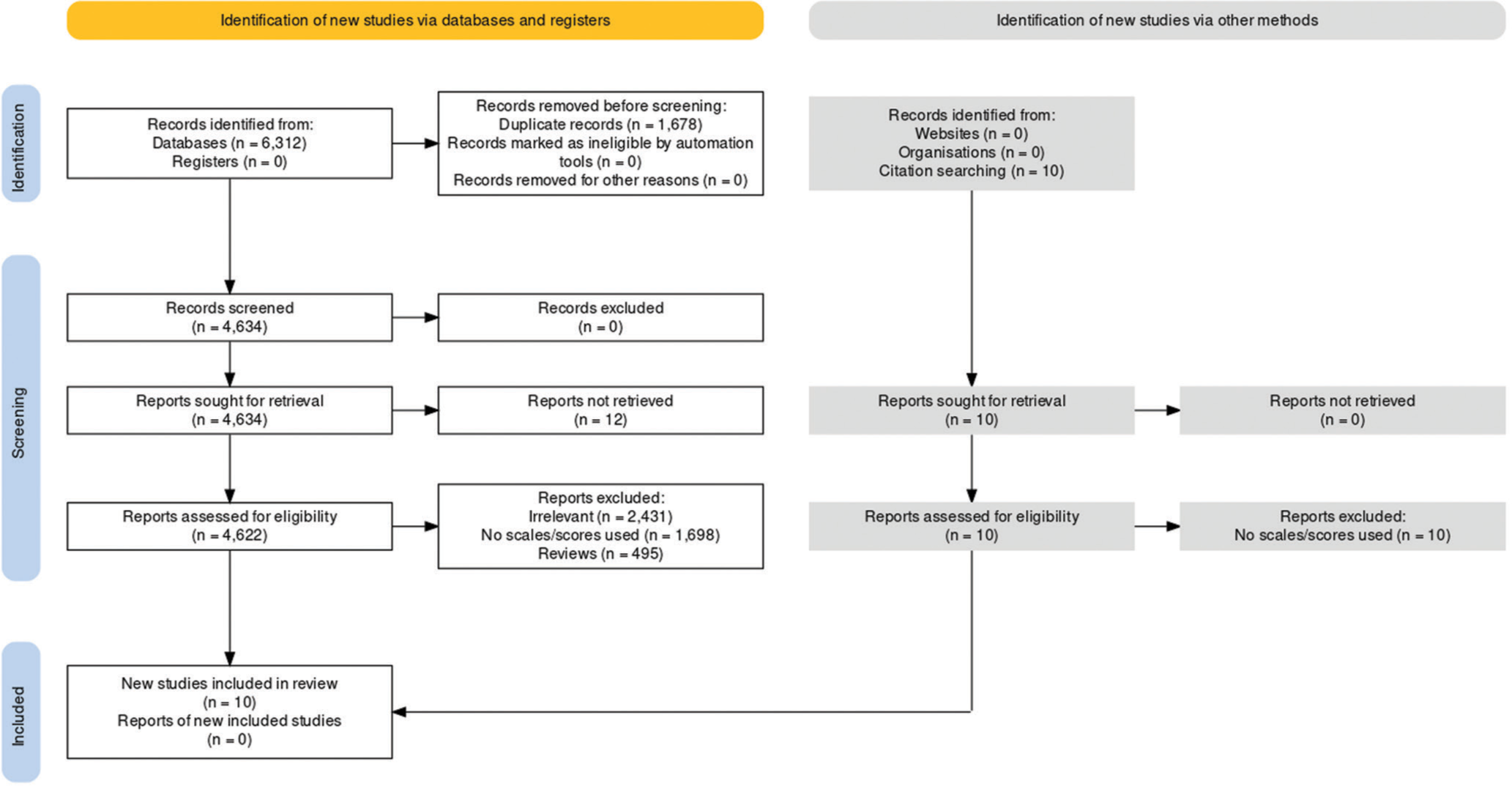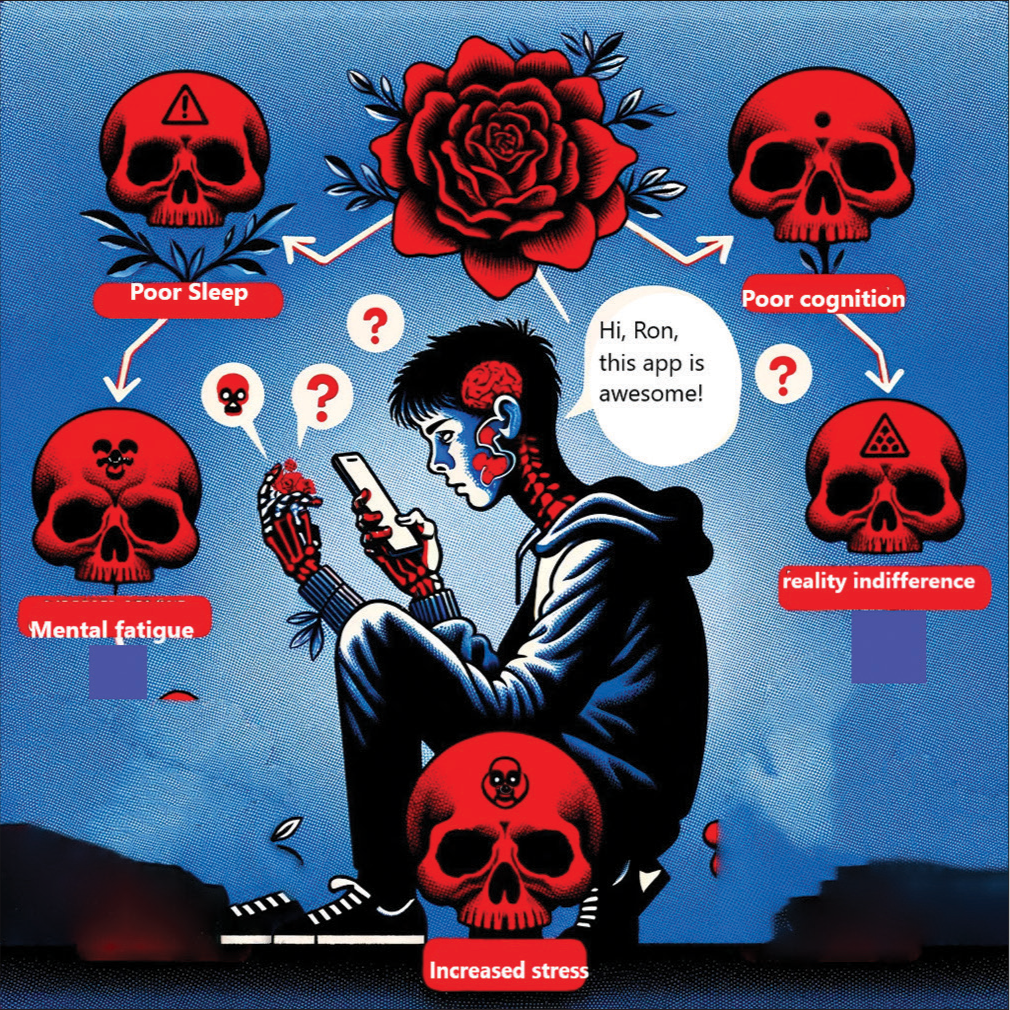Translate this page into:
Impact of smartphone use on cognitive functions: A PRISMA-guided systematic review

*Corresponding author: Sridhar Amalakanti, Department of General Medicine, AIIMS Mangalagiri, Mangalagiri, Andhra Pradesh, India. iamimenotu@gmail.com
-
Received: ,
Accepted: ,
How to cite this article: Amalakanti S, Mulpuri RP, Avula V, Reddy A, Jillella J. Impact of smartphone use on cognitive functions: A PRISMA-guided systematic review. Med India. 2024;3:2-7. doi: 10.25259/MEDINDIA_33_2023
Abstract
This systematic review provides a detailed synthesis of existing research on the impact of smartphone use on cognitive processes. Adhering to the preferred reporting items for systematic reviews and meta-analyses principles, we performed a thorough search across many databases, which led to the identification of studies that satisfied our rigorous inclusion criteria. The results of our study demonstrate a notable association between the usage of smartphones and alterations in attention span, memory retrieval, and executive functioning. These findings emphasize the importance of raising awareness and implementing interventions to reduce negative cognitive effects linked to excessive smartphone usage.
Keywords
Smartphones
Cognitive dysfunction
Attention span
Memory
Executive function
Systematic review
Preferred Reporting Items for Systematic Reviews and Meta-Analyses
INTRODUCTION
The use of smartphones has become pervasive in contemporary life, and they have evolved into a vital instrument for communication, access to information, and entertainment. On the other hand, this pervasiveness raises worries about the possibility of addiction and excessive use.[1] The idea of smartphone addiction, which is characterized by excessive and problematic use, has arisen as an important topic of inquiry, particularly with regard to the influence that it has on cognitive and mental health. There is evidence from recent research that suggests that addiction to smartphones may have an effect on a variety of facets of human cognition and mental well-being. The range of these impacts includes alterations in attention, memory, and stress levels, as well as disruptions in sleep patterns.[2] The increasing corpus of research emphasizes the importance of doing a comprehensive analysis of these effects to gain a better understanding of the scope and nature of the repercussions that are connected with smartphone addiction. The purpose of this systematic review is to compile the most recent research about the impacts of smartphone addiction on cognitive and mental health. The purpose of this review is to provide a comprehensive knowledge of the relationship between smartphone addiction and its impact on the human mind. This will be accomplished by the analysis of observational research and the utilization of standardized assessment instruments such as the Smartphone Addiction Scale. Both for the purpose of guiding future study in this fast-emerging field and for the purpose of devising measures to alleviate the detrimental impacts of smartphone addiction, the findings of this review are crucial.
METHODS
PROSPERO has been updated with the protocol for this systematic review, which has been assigned the ID 492406. To carry it out, the Preferred Reporting Items for Systematic Reviews and Meta-Analyses (PRISMA) standards were utilized [Figure 1]. The following five databases were utilized for the purpose of conducting literature searches: Scopus, Ovid MEDLINE, the Cochrane Library, Embase, PubMed, CINAHL, ProQuest, SPORTDiscus, Web of Science, and PsycINFO databases. The PRISMA flow chart is shown in Figure 1. The search strategy for this review was initially devised through a series of discussions with the investigators and some preliminary searches (S.A., A.R., V.C.R.A., J.P.J., and R.P.M). These consultations and searches were first conducted. In addition, the search technique was refined and concluded with the assistance of knowledgeable librarians at the AIIMS Mangalagiri. We included all the research that was conducted, including controlled trials, case-control studies, cross-sectional studies, and cohort studies. To meet the eligibility requirements, studies were required to investigate the effects of smartphone exposure on cognition across all age groups. For the purposes of this review, case reports, ideas, editorials, meta-analyses, review papers, and opinions were not considered. The phrases “smartphone,” “addiction,” “overuse,” “problematic use,” and “excessive use” were among the search terms that were utilized. [Supplementary Table S1] contains information regarding the search strategies that were utilized. The reference lists of the articles that were chosen were also checked for papers that were eligible for consideration. The electronic search approach is presented in [Supplementary Table S1]. Studies that included a smartphone addiction scale and a valid score/scale/criteria for the outcomes were considered for the analysis. Three authors, A.R., J.P.J., and R.P.M., conducted an independent evaluation of all the abstracts that were retrieved and chose papers that were appropriate for consideration. Any differences were settled by conversation with senior researchers (S.A. and V. C.R.A.), who were involved in the study. The quality of each of the included studies was evaluated with the help of the Quality Assessment Tool for Observational Cohort and Cross-Sectional Studies developed by the National Institutes of Health (NIH). The results of this evaluation are reported in [Supplementary Table S2]. When it comes to evaluating the methodological quality of cross-sectional research, the NIH quality evaluation provides a tool that is both valid and trustworthy.

- The Preferred Reporting Items for Systematic Reviews and Meta-Analyses flow chart.
RESULTS
It was determined that there were 6312 studies in all. A search of references led to the discovery of seventeen additional research. Following the elimination of duplicates, reviews, studies in which clear scores were not utilized, and other research that was deemed irrelevant, a total of ten studies were incorporated into the review. A summary of each of the different studies is included in Table 1.[3-12] Nine of the ten studies included students. The Smartphone Addiction Scale was the most often used scale [Table 1]. The surveys for three of the trials were completed online. It was discovered that there were three distinct studies, one of which reported on green space and the other that discussed the musculoskeletal adverse effects of smartphone addiction. In every single study, the negative impacts of using smartphones were unequivocally reported.
There were three studies that reported poor sleep,[3,7-9] two studies that revealed decreased cognition,[6,9] two studies that indicated mental exhaustion in the subjects,[6,9] two studies that found difficulty with adjusting to the real world,[10,11] and one study that found elevated stress levels.[9] The adverse effects of smartphones on the human mind is depicted in Figure 2.
| Authors | Year | Population | Age group of participants | Smartphone usage assessment scale | Cognition scale | Main findings in the result | |||
|---|---|---|---|---|---|---|---|---|---|
| Mastin, et al.[3] | 2017 | University Students | 19 years | Smartphone Addiction Scale | Epworth Sleepiness Scale (ESS), the Pittsburg Sleep Quality Index (PSQI) | Active and passive bedtime social technology use was found to be related to poorer sleep quality, greater sleepiness, and increased features associated with inadequate sleep hygiene. | |||
| Zhang[4] | 2023 | University Students | 20 years | Smartphone Addiction Scale | Emotional Intelligence Scale, the Dark Future Scale | Structural Equation Model demonstrated that Emotional Intelligence[EI] significantly and negatively influenced SmartPhone Addiction[SPA], EI significantly predicted SPA in university students. | |||
| Li, et al.[5] | 2023 | Online responders | Smartphone Addiction Scale | Depression, Anxiety and Stress Scale-21 (DASS-21),UCLA Loneliness Scale | Greenness may serve as an indicator of urbanization at national levels and that urbanization may buffer against smartphone addiction. | ||||
| Yasin S, et al.[6] | 2023 | Medical students | 18-23 | Smartphone Addiction Scale (SAS) | the Mental Fatigue Scale (MFS), and the Cognitive Flexibility Inventory (CFI) | Smartphone overuse may be an independent risk factor for the development of mental fatigue. | |||
| Hamvai, et al.[7] | 2023 | Medical students | 22.15 years | Smartphone Addiction Scale | Abbreviated Impulsiveness Scale, Bedtime Procrastination Scale, Abbreviated Impulsiveness Scale, Academic Procrastination Scale-Short Form | Attentional impulsivity was also associated with decreased cognitive capacity with a serial mediation effect via smartphone addiction, academic procrastination, bedtime procrastination, sleep insufficiency and fatigue | |||
| Chen and Zhang[8] | 2023 | University Students | Smartphone Addiction Scale | Victimization Experience Scale, Emotional Intelligence Scale | COVID-19 victimization experience was a important variables in predicting university students's martphone addiction, and emotional intelligence was a protective factor in decreasing the negative effect of COVID-19 victimization experience on addictive behaviors. | ||||
| Sanusi, et al.[9] | 2022 | Dental students | Smartphone Addiction Scale (SAS | Global Pittsburg Sleep Quality Index (PSQI),Perceived Stress Scale-10 (PSS-10) | Dental students who have high levels of smartphone addiction or high perceived stress levels experienced poor sleep quality. Identifying smartphone addicts amongst students as well as stressors are imperative measures to allow timely assistance and support in the form of educational campaigns, counselling, psychotherapy and stress management. | ||||
| Hong, et al.[10] | 2021 | Middle school student | Smartphone addiction scale | Korean ADHD rating scales (K-ARS), perceived stress scale (PSS) | The order of the usage types with the highest influence on smartphone addiction was: enjoying music/videos, SNS, and study. This suggests that selective intervention depending on the main smartphone usage type can be effective. | ||||
| Mohta R and Halder S.[11] |
2021 | Adolescent | 12-17 years | Smartphone Addiction Scale | Smartphone Addiction produces differences in Adolescent’s functioning. Smartphones comes in the way of enriched psychological experience and adjusting to a world outside their screens becomes difficult. | ||||
| İnal Ö and Serel Arslan S.[12] | 2021 | University Students | Smartphone Addiction Scale (SAS) | Cognitive flexibility was assessed with the Cognitive Flexibility Inventory (CFI),Nordic Musculoskeletal Questionnaire (NMQ) was used to evaluate musculoskeletal symptoms, and pain was measured with Visual Analog Scale (VAS) | Smartphone addiction is associated with musculoskeletal problems, pain and cognitive flexibility in university students. Encouraging an active lifestyle, physical activity, ergonomic arrangements, individual behavioral modification as well as environmental regulations and policies may eliminate the negative effects of smartphone addiction. | ||||
ESS: Epworth sleepiness scale, DASS-21: Depression, anxiety and stress scale-21, MFS: Mental fatigue scale, PSQI: Pittsburg sleep quality index, PSS-10: Perceived stress scale-10, K-ARS: Korean attention deficit hyperactivity disorder rating scales, SAS: Smartphone addiction scale, VAS: Visual analog scale, CFI: Cognitive flexibility inventory, NMQ: Nordic musculoskeletal questionnaire, SPA: Smartphone addiction, EI: Emotional intelligence, SNS: Social networking services, UCLA: University of California Los Angeles.

- Adverse effects of smartphones on the human mind.
DISCUSSION
The purpose of this systematic review was to look at the evidence that is now available on the connections between smartphone addiction and the impact it has on cognitive abilities and mental health. There were ten observational studies that satisfied the inclusion criteria, eight of which utilized the Smartphone Addiction Scale and evaluated the effects of the addiction on a variety of factors, including sleep, stress, exhaustion, real-world functioning, and flexibility. A larger addiction to smartphones was shown to be connected with a lower quality of sleep as well as higher degrees of tiredness or weariness, which was the finding that was most consistent across all of the research that was examined. As a result of psychological stimulation, decreased melatonin levels, and exposure to blue wavelength light, this is consistent with the findings of previous studies that demonstrate the detrimental effects of media use on sleep. It is possible that establishing boundaries for the use of smartphones before bedtime could be a significant focus for intervention.[13] The inability to obtain enough sleep can have a negative impact on mood, cognitive abilities, and academic performance.[14]
In addition, a higher level of addiction to smartphones was linked to deficiencies in cognitive abilities such as working memory and attention management. The continuous switching between tasks, the overstimulation of reward pathways, and the diminished top-down control that might result from problematic smartphone use can all contribute to a reduction in cognitive resources.[15] There is a need for additional research into the relationship between the usage of addictive substances and particular cognitive abilities. It is important to note that three studies have highlighted the possibility that addiction to smartphones can limit the ability of university students to adjust and be flexible in the real world. Based on this, it appears that an excessive reliance on cell phones may hinder the development of skills necessary for independent problem-solving and adaptation. In the future, research might investigate whether or whether improving one’s ability to self-regulate aids in mitigating the effects of these consequences during the crucial transition from secondary school to adulthood. The research that was examined showed, time and time again, that addiction to smartphones can have a severe influence on both mental health and performance. Nonetheless, the research has some shortcomings, one of which is that it does not have any longitudinal data that establishes directional links over time. There is also a need for research that is experimental and neuroimaging to understand mechanisms such as the reinforcement of dopamine release. In addition, the majority of research used self-report scales to evaluate smartphone addiction; therefore, the reliability of the results could be improved using more objective behavioral measures.
CONCLUSION
This systematic review provides a synthesis of the increasing linkages between the use of smartphones that are addictive and sleep disturbances, reduced cognition, decreased stress resilience, and maladaptive rigidity. As a result of the widespread use of smartphones, there is a pressing need for increased public awareness and suggestions that are supported by evidence regarding the importance of maintaining a healthy balance between digital consumption and productivity.
Ethical approval
The Institutional Review Board approval is not required.
Declaration of patient consent
Patient’s consent was not required as there are no patients in this study.
Conflicts of interest
There are no conflicts of interest.
Use of Artificial Intelligence (AI)-Assisted Technology for manuscript preparation
The authors confirm that there was no use of artificial intelligence (AI)-assisted technology for assisting in the writing or editing of the manuscript and no images were manipulated using AI.
Financial support and sponsorship
Nil.
References
- A holistic investigation of the relationship between digital addiction and academic achievement among students. Eur J Investig Health Psychol Educ. 2023;13:2006-34.
- [CrossRef] [PubMed] [Google Scholar]
- Smartphone addiction among students and its harmful effects on mental health, oxidative stress, and neurodegeneration towards future modulation of anti-addiction therapies: A comprehensive survey based on SLR, research questions, and network visualization techniques. CNS Neurol Disord Drug Targets. 2023;22:1070-89.
- [CrossRef] [PubMed] [Google Scholar]
- Active and passive bedtime social technology use related to daytime sleepiness and sleep. Sleep. 2017;40(suppl_1):A60.
- [CrossRef] [Google Scholar]
- Smartphone addiction among university students' during the post-COVID-19 era: The role of emotional intelligence and future anxiety. Psychiatry Investig. 2023;20:951-61.
- [CrossRef] [PubMed] [Google Scholar]
- Potential pathways of association from green space to smartphone addiction. Environ Pollut. 2023;331:121852.
- [CrossRef] [PubMed] [Google Scholar]
- Digital danger in our pockets: Effect of smartphone overuse on mental fatigue and cognitive flexibility. J Nerv Ment Dis. 2023;211:621-6.
- [CrossRef] [PubMed] [Google Scholar]
- Association between impulsivity and cognitive capacity decrease is mediated by smartphone addiction, academic procrastination, bedtime procrastination, sleep insufficiency and daytime fatigue among medical students: A path analysis. BMC Med Educ. 2023;23:537.
- [CrossRef] [PubMed] [Google Scholar]
- COVID-19 victimization experience and university students' smartphone addiction: The mediating role of emotional intelligence. BMC Public Health. 2023;23:1410.
- [CrossRef] [PubMed] [Google Scholar]
- The association of smartphone addiction, sleep quality and perceived stress amongst Jordanian dental students. Eur J Dent Educ. 2022;26:76-84.
- [CrossRef] [PubMed] [Google Scholar]
- Relationships between smartphone addiction and smartphone usage types, depression, ADHD, stress, interpersonal problems, and parenting attitude with middle school students. J Korean Med Sci. 2021;36:e129.
- [CrossRef] [PubMed] [Google Scholar]
- A comparative study on cognitive, emotional, and social functioning in adolescents with and without smartphone addiction. J Indian Assoc Child Adolesc Ment Health. 2021;17:44-65.
- [CrossRef] [Google Scholar]
- Investigating the effect of smartphone addiction on musculoskeletal system problems and cognitive flexibility in university students. Work. 2021;68:107-13.
- [CrossRef] [PubMed] [Google Scholar]
- The potential influence of LED lighting on mental illness. World J Biol Psychiatry. 2018;19:59-73.
- [CrossRef] [PubMed] [Google Scholar]
- Effect of sleep and mood on academic performance-at interface of physiology, psychology, and education. Humanit Soc Sci Commun. 2022;9:1-13.
- [CrossRef] [Google Scholar]
- A review of evidence on the role of digital technology in shaping attention and cognitive control in children. Front Psychol. 2021;12:611155.
- [CrossRef] [PubMed] [Google Scholar]






